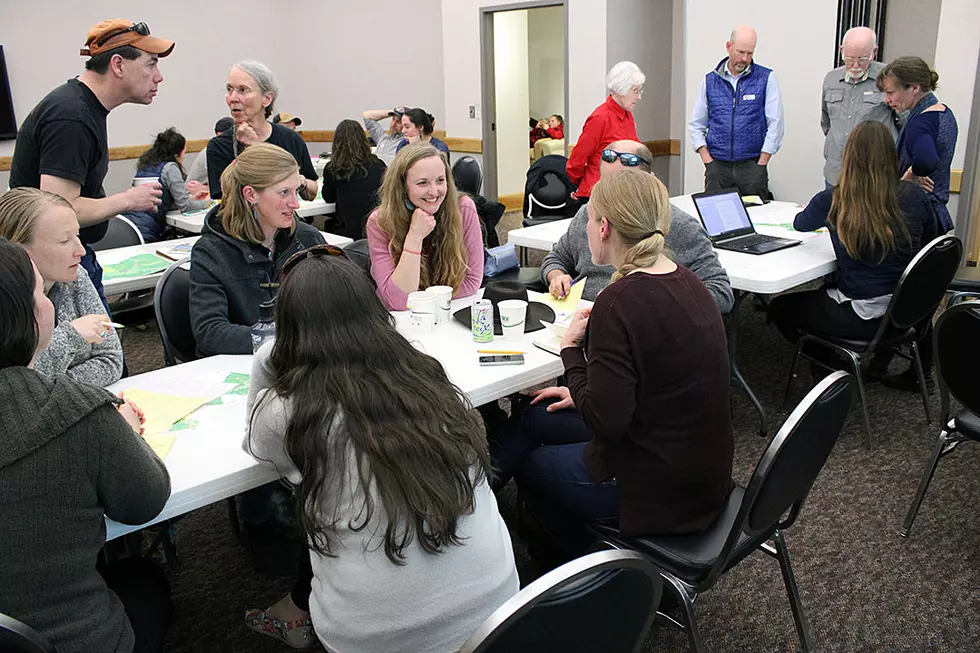
New effort focuses on restoration of Clark Fork River tributaries in central basin
Clark Fork River restoration and habitat conservation organizations, along with residents of Missoula, Granite and Mineral counties, met on Tuesday night to discuss which tributaries should be prioritized for restoration in those counties.
The Clark Fork Kootenai River Basins Council hosted the event as part of an effort to create a watershed restoration plan for the central Clark Fork Basin, from Flint Creek to the Flathead River.
It is one of the only sections of the Clark Fork Basin without an approved restoration plan, said Vicki Watson, University of Montana environmental studies professor and a member of the Clark Fork Kootenai River Basins Council.
Funding has been the limiting factor.
But providing the Department of Environmental Quality with a comprehensive watershed restoration plan is a major step toward 319 funds, restoration money available through the Clean Water Act.
“The Missoula Conservation District has provided funding for channel migration mapping, fish passage improvement projects and preparing for dam removal on the Rattlesnake Creek," Watson said. "We’re already getting a lot of stuff done, but there is still a lot that remains to be done and usually the limiting factor is funding."
The plan will identify health goals for water bodies of interest, or those that are impaired or contaminated, to achieve water quality standards. It will also outline financial assistance, education and outreach to encourage public participation, actions to improve water quality and provide a schedule for implementation.
Total Maximum Daily Load studies, or TMDL, were conducted for the region to determine how much various pollutants must be reduced for the stream to meet water quality standards.
“We’re trying to keep it as short and focused as we can and not do everything at once," Watson said. "We want to talk about some general goals, talk about a few key projects, describe them up front and say, ‘We’ll come back and consider more projects in the future when we update it.’ ”
The main goal is to identify pollutant load reductions, describe common themes and prioritize projects for the first five years of the plan.
Common sources of stream impairment or pollution include sediment, flow and habitat alteration, floodplains, agriculture, forestry, urban development, mining and others. Nonpoint pollutants that don’t have one identifiable source include fertilizers, oil, toxic chemicals, and sediment from improperly managed construction sites.
Multiple organizations, including Trout Unlimited, the Montana Department of Environmental Quality and Montana Fish Wildlife & Parks, have participated in the process.
Since 2000, Montana organizations have carried out over 70 restoration projects involving 30 creeks in the central Clark Fork Basin.
A few groups that focused on Missoula County during Tuesday’s meeting were concerned about subdivision development on land around Albert Creek, Deep Creek and Rock Creek. Other groups explained that education was the top priority, identifying grazing as a pollutant and encouraging ranchers to move livestock away from water.
Missoula County resident Apryl Lange expressed concern over habitat conservation along Grant Creek.
“We want to protect the habitat that’s there. We’re not against the landowners, we understand that’s how you make money. But it’s possible that they don’t even know it’s here,” Lange said.
She said wetlands in the Grant Creek area are home to many species, including foxes, owls, eagles, blue herons, pheasants and others. Lange said the Grant Creek floodplain is adjacent to her home, and she wants to keep high-density home development away from the area.
Her neighborhood was built in the 1990s, and most of the homes, including hers, have large yards that better accommodate wildlife.
“44 Ranch is the subdivision and it’s coming closer every month, and they’re right up to the water’s edge,” Lange said. “I don’t know what we can do on private property, but a corner of this creek, it does look like it runs through public lands on the map. I’m hoping that is a shining light at the end of the tunnel.”
Ward 1 City Council member Heidi West also attended, saying the city wants to know more about restoration and where it lies within the cycle of the area’s water.
“I think it’s important to remember as people that we’re part of a cycle. It’s almost this whole water cycle," West said. "We draw our drinking water from the aquifer below us and then we live on the landscape. Whether we pick up our dog waste and when trash is left on the road, all of those things impact what ends up infiltrating into our water below us or potentially going out into the river."
Missoula has owned the city’s water utility for about a year now, and West said it can invest in the storm water and sewer systems and keep it maintained. In her ward, the Rattlesnake Creek Dam is undergoing demolition and habitats will soon be restored, thanks to the city purchasing the local storm water utility.
“I’m really hopeful, and I think there are a lot of great things we can do,” West said.
Started in the fall of 2018, the central Clark Fork restoration plan will be 20 to 30 pages long when complete, followed by an appendix with a section for each creek. The plan should be completed in 2019, and submitted to the Montana Department of Environmental Quality for approval in early 2020. Future public meetings may be announced in the coming months.
Visit the website for more information.
Reporter Mari Hall can be contacted via email at mari.hall@missoulacurrent.com.
